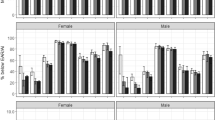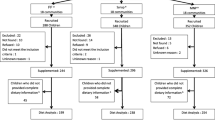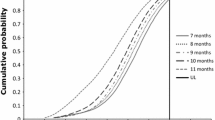Abstract
Purpose
There are limited data on the contribution of fortified foods and nutritional supplements to intakes of vitamin D in young children. Our objective was to examine the intake, adequacy, risk of excessive intake and sources of dietary vitamin D.
Methods
The nationally representative cross-sectional dietary survey of young children (aged 1–4 years) (n 500) was used to evaluate vitamin D intake and quantify the contribution of the base diet, fortified foods and nutritional supplements to total intake.
Results
Median (IQR) intakes of vitamin D were generally low in this young population, ranging from 2.0 (1.9) to 2.5 (4.9) µg/day. Ninety-three and 78 % of children had intakes below 10 and 5 µg/day, respectively. While vitamin D supplement users (17 %) had the highest intakes [6.7 (6.4) µg/day] (P < 0.001), 74 % had intakes below 10 µg/day. Vitamin D-fortified foods, consumed by 77 % of children [2.2 (2.0) µg/day], made nutritionally significant contributions to intake [0.8 (1.6) µg/day], particularly in younger children [1.5 (4.6) µg/day]. Children who did not use nutritional supplements or fortified foods had significantly (P < 0.001) lower intakes of vitamin D than the other groups [1.0 (0.8) µg/day]. Our analyses show the importance of milk and yoghurt, meat and fortified ready-to-eat cereals as sources of vitamin D in this age group. The use of nutritional supplements or fortified foods at current levels does not represent a risk of intakes exceeding the European Food Safety Authority (EFSA) tolerable upper intake level (UL) (50 µg/day), as intakes did not exceed or even approach the UL (P95: 22 % of UL).
Conclusion
Intakes of vitamin D in preschool children in Ireland are generally low. Nutritional supplements and fortified foods make significant contributions to intakes of vitamin D, without risk of unacceptably high intakes. Though supplements are effective in raising intakes of vitamin D in users, uptake is low (17 %). Food fortification may represent a suitable public health approach to increasing vitamin D intakes. The national food consumption data of Irish preschool children provide the ideal starting point for modelling of fortification scenarios to identify which foods and levels of addition will ensure effective and safe increases in vitamin D intake.

Similar content being viewed by others
References
Holick MF (2007) Vitamin D deficiency. N Engl J Med 357(3):266–281. doi:10.1056/NEJMra070553
Holick MF (2004) Sunlight and vitamin D for bone health and prevention of autoimmune diseases, cancers, and cardiovascular disease. Am J Clin Nutr 80(6 Suppl):1678s–1688s
Webb AR, Kift R, Durkin MT, O’Brien SJ, Vail A, Berry JL, Rhodes LE (2010) The role of sunlight exposure in determining the vitamin D status of the UK white adult population. Br J Dermatol 163(5):1050–1055. doi:10.1111/j.1365-2133.2010.09975.x
Carruth BR, Skinner J, Houck K, Moran J 3rd, Coletta F, Ott D (1998) The phenomenon of “picky eater”: a behavioral marker in eating patterns of toddlers. J Am Coll Nutr 17(2):180–186
Mascola AJ, Bryson SW, Agras WS (2010) Picky eating during childhood: a longitudinal study to age 11-years. Eat Behav 11(4):253–257. doi:10.1016/j.eatbeh.2010.05.006
Carruth BR, Ziegler PJ, Gordon A, Barr SI (2004) Prevalence of picky eaters among infants and toddlers and their caregivers’ decisions about offering a new food. J Am Diet Assoc 104(1):S57–S64. doi:10.1016/j.jada.2003.10.024
Bates B, Lennox A, Prentice A, Bates C, Page P, Nicholson S, Swan G (2014) National diet and nutrition survey results from years 1, 2, 3 and 4 (combined) of the Rolling Programme (2008/2009–2011/2012). Public Health England. https://www.gov.uk/government/uploads/system/uploads/attachment_data/file/310995/NDNS_Y1_to_4_UK_report.pdf
Mensink GBM, Fletcher R, Gurinovic M, Huybrechts I, Lafay L, Serra-Majem L, Szponar L, Tetens I, Verkaik-Kloosterman J, Baka A, Stephen AM (2013) Mapping low intake of micronutrients across Europe. Br J Nutr 110:755–773. doi:10.1017/S000711451200565X
Kyttälä P, Erkkola M, Kronberg-Kippilä C, Tapanainen H, Veijola R, Simell O, Knip M, Virtanen SM (2010) Food consumption and nutrient intake in Finnish 1–6-year-old children. Public Health Nutr 13(6A):947–956. doi:10.1017/S136898001000114X
Pietinen P, Männistö S, Valsta LM, Sarlio-Lähteenkorva S (2010) Nutrition policy in Finland. Public Health Nutr 13(6A):901–906. doi:10.1017/S1368980010001072
Piirainen T, Laitinen K, Isolauri E (2007) Impact of national fortification of fluid milks and margarines with vitamin D on dietary intake and serum 25-hydroxyvitamin D concentration in 4-year-old children. Eur J Clin Nutr 61(1):123–128. doi:10.1038/sj.ejcn.1602506
Moore CE, Murphy MM, Holick MF (2005) Vitamin D intakes by children and adults in the United States differ among ethnic groups. J Nutr 135(10):2478–2485
Vatanparast H, Calvo MS, Green TJ, Whiting SJ (2010) Despite mandatory fortification of staple foods, vitamin D intakes of Canadian children and adults are inadequate. J Steroid Biochem Mol Biol 121(1–2):301–303. doi:10.1016/j.jsbmb.2010.03.079
Ocké MC, van Rossum CTM, Fransen HP, Buurma EJM, de Boer EJ, Brants HAM, Niekerk EM, van der Laan JD, Drijvers JJMM, Ghameshlou Z (2008) Dutch National Food Consumption Survey—Young Children 2005/2006. Bilthoven: (RIVM) National Institute for Public Health and the Environment
Sichert-Hellert W, Wenz G, Kersting M (2006) Vitamin intakes from supplements and fortified food in German children and adolescents: results from the DONALD Study. J Nutr 136(5):1329–1333
Irish Universities Nutrition Alliance (2012) National Pre-School Nutrition Survey. Summary Report on: Food and Nutrient Intakes, Physical Measurements and Barriers to Healthy Eating. IUNA, Dublin
Central Statistics Office (2007) Census 2006: Principle Demographic Results. The Stationary Office, Dublin
Harrington K, Robson P, Kiely M, Livingstone M, Lambe J, Gibney M (2001) The North/South Ireland food consumption survey: survey design and methodology. Public Health Nutr 4(5a):1037–1042. doi:10.1079/PHN2001184
Foster E, Hawkins A, Adamson A (2010) Young person’s food atlas: pre-school. Food Standards Agency, London
Food Standards Agency (2002) Food portion sizes, 3rd edn. The Stationery Office, London
Food Standards Agency (2002) McCance and Widdowson’s the composition of foods, sixth, Summary edn. Royal Society of Chemistry, Cambridge
Holland B, Welch AA, Unwin ID, Buss DH, Paul AA, Southgate DAT (1995) McCance and Widdowson’s the composition of foods, 5th edn. HMSO, London
Holland B, Unwin ID, Buss DH (1988) Cereal and Cereal Products. Third supplement to McCance & Widdowson’s the composition of foods, 4th edn. HMSO, London
Holland B, Unwin ID, Buss DH (1989) Milk Products and Eggs. Fourth supplement to McCance & Widdowson’s the composition of foods, 4th edn. HMSO, London
Holland B, Unwin ID, Buss DH (1991) Vegetables, Herbs and Spices. Fifth supplement to McCance & Widdowson’s the composition of foods, 4th edn. HMSO, London
Holland B, Unwin ID, Buss DH (1992) Fruits and Nuts. First supplement to McCance & Widdowson’s the composition of foods, 5th edn. HMSO, London
Holland B, Brown J, Buss DH (1993) Fish and fish products. third supplement to McCance & Widdowson’s the composition of foods, 5th edn. HMSO, London
Chan W, Brown J, Buss DH (1994) Miscellaneous foods. Fourth supplement to McCance & Widdowson’s the composition of foods, 5th edn. HMSO, London
Chan W, Brown J, Lee SJ, Buss DH (1995) Meat, poultry and game. Fifth supplement to McCance & Widdowson’s the composition of foods, 5th edn. HMSO, London
Chan W, Brown J, Church SM, Buss DH (1996) Meat products and dishes. Sixth supplement to McCance & Widdowson’s the composition of foods, 5th edn. HMSO, London
Holland B, Welch AA, Buss DH (1996) Vegetable dishes. second supplement to McCance and Widdowson’s the composition of foods, 5th edn. HMSO, London
Black LJ, Ireland J, Møller A, Roe M, Walton J, Flynn A, Finglas PM, Kiely M (2011) Development of an on-line Irish food composition database for nutrients. J Food Comp Anal 24(7):1017–1023. doi:10.1016/j.jfca.2011.01.015
USDA National Nutrient Database for Standard Reference, Release 20 (2007). http://www.ars.usda.gov/nutrientdata
EC (2007) Council Regulation (EC) No 1234/2007 of 22 October 2007 establishing a common organisation of agricultural markets and on specific provisions for certain agricultural products (Single CMO Regulation). Off J Eur Union L299:1–149
Black LJ, Walton J, Flynn A, Kiely M (2014) Adequacy of vitamin D intakes in children and teenagers from the base diet, fortified foods and supplements. Public Health Nutr 17(04):721–731. doi:10.1017/S1368980013000359
Krebs-Smith S, Kott P, Guenther P (1989) Mean proportion and population proportion: Two answers to the same question? J Am Diet Assoc 89(5):671–676
Beaton GH (1994) “Criteria of an adequate diet” In: Shils RE, Olsen JA, Shike M (eds) Modern Nutrition in Health and Disease. Philadelphia: Lea & Febiger
Institute of Medicine (2000) Dietary reference intakes: a report of the Subcommittees on Interpretation and Uses of Dietary Reference Intakes and the Standing Committee on the Scientific Evaluation of Dietary Reference Intakes, Food and Nutrition Board. National Academies Press, Institute of Medicine. Applications in dietary assessment
Institute of Medicine, Food and Nutrition Board (2011) Dietary Reference Intakes for Calcium and Vitamin D. National Academies Press, Washington
Schofield WN, Schofield C, James WPT (1985) Basal metabolic rate. Human Nutrition Clinical Nutrition 39C(Suppl 1):1–96
Torun B, Davies PSW, Livingstone MBE, Paolisso M, Sackett R, Spurr GB, deGuzman MPE (1996) Energy requirements and dietary energy recommendations for children and adolescents 1 to 18 years old. Eur J Clin Nutr 50:S37–S81
Goldberg G, Black A, Jebb S, Cole T, Murgatroyd P, Coward W, Prentice A (1991) Critical evaluation of energy intake data using fundamental principles of energy physiology: 1. Derivation of cut-off limits to identify under-recording. Eur J Clin Nutr 45:569–581
Sichert-Hellert W, Kersting M, Schoch G (1998) Underreporting of energy intake in 1 to 18 year old German children and adolescents. Z Ernährungswiss 37(3):242–251
European Food Safety Authority Panel on Dietetic Products NaA (2012) Scientific opinion on the tolerable upper intake level of vitamin D. EFSA J 10(7):2813. doi:10.2903/j.efsa.2012.2813. http://www.efsa.europa.eu/en/efsajournal/doc/2813.pdf
Emmett P, Rogers I, Symes C (2002) Food and nutrient intakes of a population sample of 3-year-old children in the South West of England in 1996. Public Health Nutr 5(01):55–64. doi:10.1079/PHN2001241
Cashman KD, Muldowney S, McNulty B, Nugent A, FitzGerald AP, Kiely M, Walton J, Gibney MJ, Flynn A (2013) Vitamin D status of Irish adults: findings from the National Adult Nutrition Survey. Br J Nutr 109(07):1248–1256. doi:10.1017/S0007114512003212
Hayes E, Walton J, Hannon EM, Flynn A (2008) Micronutrient intake in Irish teenagers (13-17 years). Proc Nutr Soc 67(OCE7):E275
Hill TR, O’Brien MM, Cashman KD, Flynn A, Kiely M (2004) Vitamin D intakes in 18-64y-old Irish adults. Eur J Clin Nutr 58:1509–1517
ní Chaoimh C, McCarthy EK, Murray D, Kenny LC, Hourihane JB, Irvine A, Lyons J, Kiely M (2013) Vitamin D intakes and dietary sources in children aged 2yrs in the Cork BASELINE Birth Cohort Study. Proc Nutr Soc 72(OCE3):E113
Whiting SJ, Langlois KA, Vatanparast H, Greene-Finestone LS (2011) The vitamin D status of Canadians relative to the 2011 Dietary Reference Intakes: an examination in children and adults with and without supplement use. Am J Clin Nutr 94(1):128–135. doi:10.3945/ajcn.111.013268
Whitton C, Nicholson SK, Roberts C, Prynne CJ, Pot GK, Olson A, Fitt E, Cole D, Teucher B, Bates B, Henderson H, Pigott S, Deverill C, Swan G, Stephen AM (2011) National Diet and Nutrition Survey: UK food consumption and nutrient intakes from the first year of the rolling programme and comparisons with previous surveys. Br J Nutr 106(12):1899–1914. doi:10.1017/s0007114511002340
Butte NF, Fox MK, Briefel RR, Siega-Riz AM, Dwyer JT, Deming DM, Reidy KC (2010) Nutrient intakes of US infants, toddlers, and preschoolers meet or exceed dietary reference intakes. J Am Diet Assoc 110(12):S27–S37. doi:10.1016/j.jada.2010.09.004
Lennox A, Sommerville J, Ong K, Henderson H, Allen R (2011) Diet and Nutrition Survey of Infants and Young Children [online]. Food Standards Agency and the Department of Health
Sommerville J, Henderson H, Pell D, Ong K, Mistry P, Cox L, Allen R, Stephen A (2013) Vitamin D intake and status in the diet and nutrition survey of infants and young children 2011 (DNSIYC). Proc Nutr Soc 72(OCE3):E114
Cribb VL, Northstone K, Hopkins D, Emmett PM (2014) Sources of vitamin D and calcium in the diets of preschool children in the UK and the theoretical effect of food fortification. J Hum Nutr Diet. doi:10.1111/jhn.12277
Bates B, Lennox A, Prentice A, Bates C, Swan G (2012) National diet and nutrition survey. Headline results from years 1, 2 and 3 (combined) of the Rolling Programme (2008/2009–2010/2011) [online]. Food Standards Agency and the Department of Health
Food Safety Authority of Ireland (2007) Recommendations for a national policy on vitamin D supplementation for infants in Ireland. Food Safety Authority of Ireland, Dublin
Browne F (2013) National food consumption surveys: micronutrient intakes and the role of nutritional supplements in the diets of Irish adults and pre-school children. University College Cork, Cork
Carroll A, Onwuneme C, McKenna MJ, Mayne PD, Molloy EJ, Murphy NP (2014) Vitamin D status in Irish children and adolescents: value of fortification and supplementation. Clin Pediatr. doi:10.1177/0009922814541999
Hennessy Á (2013) National food consumption surveys: micronutrient intakes and the role of fortified foods in the diets of Irish pre-school children and adults. University College Cork, Cork
Flynn A, Hirvonen T, Mensink GBM, Ocke MC, Serra-Majem L, Stos K, Szponar L, Tetens I, Turrini A, Fletcher R, Wildemann T (2009) Intake of selected nutrients from foods, from fortification and from supplements in various European countries. Food Nutr Res 53:S1–S28. doi:10.3402/fnr.v53i0.2038
Spiro A, Buttriss JL (2014) Vitamin D: an overview of vitamin D status and intake in Europe. Nutr Bull 39(4):322–350. doi:10.1111/nbu.12108
Piirainen T, Laitinen K, Isolauri E (2007) Impact of national fortification of fluid milks and margarines with vitamin D on dietary intake and serum 25-hydroxyvitamin D concentration in 4-year-old children. Eur J Clin Nutr 61:123–128
Bailey RL, Dodd KW, Goldman JA, Gahche JJ, Dwyer JT, Moshfegh AJ, Sempos CT, Picciano MF (2010) Estimation of total usual calcium and vitamin D intakes in the United States. J Nutr 140(4):817–822. doi:10.3945/jn.109.118539
Fulgoni VL 3rd, Keast DR, Bailey RL, Dwyer J (2011) Foods, fortificants, and supplements: Where do Americans get their nutrients? J Nutr 141(10):1847–1854. doi:10.3945/jn.111.142257
El Hayek J, Pham TT, Finch S, Hazell TJ, Jean-Philippe S, Vanstone CA, Agellon S, Rodd C, Rauch F, Weiler HA (2013) Vitamin D status in montréal preschoolers is satisfactory despite low vitamin D intake. J Nutr 143(2):154–160. doi:10.3945/jn.112.169144
Livingstone MBE, Robson PJ, Wallace JMW (2004) Issues in dietary intake assessment of children and adolescents. Br J Nutr 92(SupplementS2):S213–S222. doi:10.1079/BJN20041169
Food Safety Authority of Ireland (2011) Scientific recommendations for healthy eating guidelines in Ireland. FSAI, Dublin
Acknowledgments
The national nutrition survey of preschool children in Ireland was funded by a grant to Albert Flynn from the Irish Department of Agriculture, Food and the Marine (DAFM). The DAFM had no role in the design and analysis of the study or in the writing of this article. We would like to thank the study participants and their parents/guardians for their time and dedication in completing the survey.
Author information
Authors and Affiliations
Corresponding author
Ethics declarations
Conflict of interest
Á. Hennessy, F. Browne, M. Kiely, J. Walton and A. Flynn have no conflicts of interest.
Rights and permissions
About this article
Cite this article
Hennessy, Á., Browne, F., Kiely, M. et al. The role of fortified foods and nutritional supplements in increasing vitamin D intake in Irish preschool children. Eur J Nutr 56, 1219–1231 (2017). https://doi.org/10.1007/s00394-016-1171-7
Received:
Accepted:
Published:
Issue Date:
DOI: https://doi.org/10.1007/s00394-016-1171-7




